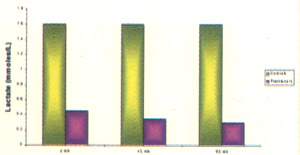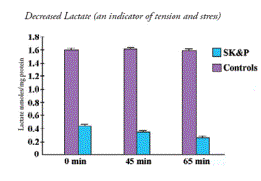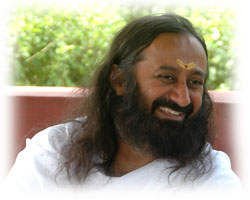::::What is Sudershan Kriya::::

These simple, yet powerful breathing practices have a unique advantage over many other forms of treatment: they are free from unwanted side-effects, can cut health care costs, and are easy to learn and practice in daily life. The Art of Living International Research and Health Promotion Center aims to promote timely and scholarly investigation of the SK&P as they relate to physical, social, and emotional well-being.
- Reduce levels of stress (reduce cortisol - the "stress" hormone)
- Support the immune system
- Reduce cholesterol
- Relieve anxiety and depression (mild, moderate and severe)
- Enhance brain function (increased mental focus, calmness and recovery from stressful stimuli)
- Enhance well-being and peace of mind
Effects of Sudershan Kriya
Over
a period of centuries, many techniques have been introduced by sages
and rishis to prevent or alter our reaction to stresses. Yoga, meditation
and pranayam (P) are well known. More recently Sudarshan Kriya Yoga
(SKY) has been introduced by His Holiness Sri Sri Ravi Shankar Ji. Pranayam
is an ancient knowledge. It directs or regulates the "prana", subtle
life force energy. Regular practice of Pranayam activates and harmonizes
many body and mind rhythms including that of brain, heartbeat, enzymes
and also mental and emotional rhythms. Sudarshan Kriya Yoga (SKY) is
a rhythmic breathing process where three rhythms are followed in a cyclical
fashion. This technique is communicated to participants through Art
of Living workshops: 22-24 hours programme spread over 6 days. According
to His Holiness Sri Sri Ravi Shankar Ji (discoverer of Sudarshan Kriya),
an intimate link exists between our thoughts, emotions and pattern of
breath. Short breath indicates emotions like anger excitement and fear,
while long deep and steady breath happens when mind is calm and intuitive.
Feelings produce sensations in the body, which in turn are linked to
pattern of breath. Sri Sri Ravi Shankar Ji states - "Breath is one of
the mystery of existence and the deeper mystery of our consciousness."
Study in AIIMS and NimHANS
In India both National Institute of Mental Health and Neurosciences (NIMHANS), Bangalore, and All India Institute of Medical Sciences (AIIMS), Delhi have been carrying out research on these practices and their effects. Clinical trials at NIMHANS, Bangalore, showed that regular practise of Sudarshan Kriya Yoga (SKY) – a set of breathing techniques promoted by Sri Sri Ravishankar, founder of the Bangalore based Art of Living Foundation – reduces symptoms of mental depression. NIMHANS researchers claim that SKY is as effective as the established anti-depressant drug imipramine, a tricyclic antidepressant, (Depsonil, Antidep). All India Institute of Medical Sciences (AIIMS), Delhi, has reported that SKYand Pranayam sessions reduced serum cortisol levels – an indicator of stress – in the blood more effectively than listening to classical music. They are also employing SKY to cure alcohol and tobacco addiction.
 It
has been reported that the distorted dream stage EEG brainwave patterns
of the depressed people, the dream-stage EEG patterns significantly
improved. Depressed people have a particular EEG brainwave abnormality,
which is measured by the P300 ERP amplitude. When P300 was post-tested
at day 90 it had returned to normal, (it was indistinguishable from
normal controls) and they remained depression free. There was a reduction
in REM latency onset and an improvement in NREM stages. About 70% of
patients completing the program experienced remission from depression,
both at the one month and the three month retest times. Blood analysis
revealed statistically significant elevation of plasma prolactin levels
after the very first SKY session. This is important since elevated plasma
prolactin may be crucial in producing an anti-depressant response. Cortisol
( a stress hormone) levels remained stable, indicating that the practice
of Sudarshan Kriya is not stressful.
It
has been reported that the distorted dream stage EEG brainwave patterns
of the depressed people, the dream-stage EEG patterns significantly
improved. Depressed people have a particular EEG brainwave abnormality,
which is measured by the P300 ERP amplitude. When P300 was post-tested
at day 90 it had returned to normal, (it was indistinguishable from
normal controls) and they remained depression free. There was a reduction
in REM latency onset and an improvement in NREM stages. About 70% of
patients completing the program experienced remission from depression,
both at the one month and the three month retest times. Blood analysis
revealed statistically significant elevation of plasma prolactin levels
after the very first SKY session. This is important since elevated plasma
prolactin may be crucial in producing an anti-depressant response. Cortisol
( a stress hormone) levels remained stable, indicating that the practice
of Sudarshan Kriya is not stressful.
study of brain by using electroencephalogram (EEG) has been used to study changes during meditation and also long-term effects of regular practice of meditation and relaxing techniques on the mind. The study was conducted on two groups in the resting state—Group I had 19 regular practitioners of Sudarshan Kriya and Group II included 15 healthy non-practitioners of Sudarshan Kriya. The study revealed a significant increase in the alpha and beta activities in Group I as compared to Group II, indicating that long practice of Sudarshan Kriya leaves one more alert/aware/attentive and more focussed. Alpha waves indicated more relaxed state of mind.
There was recently a symposium at Delhi, which cautioned that larger groups have to be studied before firm conclusions can be drawn. Dr Vinod Kochupillai, professer and head of medical oncology at AIIMS who has coordinated these studies, says that the available data on SKY and Pranayam seems to validate the claims that such practices lead to a healthier body, calmer mind and balanced emotions.
Effects of Sudershan Kriya on Body, mind and emotion
Pertinent issue is whether practices of SKY & P and other yogic and meditative states bring about changes in the functioning of the brain, in our attitudes, thinking, emotions and in our body physiology and/or pathology.
T here
are suggestions that even though broad outlines of neural connections
are genetically determined, synaptic transmissions and neurotransmitter
profile of human brain is subject to change. This phenomenon, called
as neural plasticity, is utilized by yogic practices, breathing processes
and meditative states, to bring about changes in the structure and function
of the brain.
here
are suggestions that even though broad outlines of neural connections
are genetically determined, synaptic transmissions and neurotransmitter
profile of human brain is subject to change. This phenomenon, called
as neural plasticity, is utilized by yogic practices, breathing processes
and meditative states, to bring about changes in the structure and function
of the brain.
Dr. Manveer Bhatia of the Neurology department of AIIMS analysed computer based data of EEG done during SKY & P among regular practitioners, as also their resting EEG. She demonstrated changes in alpha, beta and theta activity and increase in galvanic skin resistance (GSR). Changes observed suggested, increased connectivity and greater information processing. The central midline theta activity and increased beta activity along with an increase in GSR suggested activation and the increased alpha suggested relaxation. Thus there was a combination of relaxation and activation during SKY. Part of this work has been accepted for publication in Indian Journal of Physiology & Pharmacology.
Relaxing effects of SKY & P
Achievement of state of relaxation was further demonstrated by lower blood cortisol (stress hormone) in long term practitioners of SKY and further fall during SKY as also the fall in blood lactate levels after SKY among police trainees at New Delhi.
 Age,
sex and living conditions in police training college were similar. For
the lactate study, 24 subjects were chosen (10 amongst experimental
group and 14 controls). Experimental group had practised SKY & P for
5 months while control group was not exposed to it.
Age,
sex and living conditions in police training college were similar. For
the lactate study, 24 subjects were chosen (10 amongst experimental
group and 14 controls). Experimental group had practised SKY & P for
5 months while control group was not exposed to it.
Basal blood lactate level was lower to begin with in those practising SKY & P compared to control and there was a further fall during Kriya (p = 0.0006).
Effect on Blood Lactate
 Indicator
of stress and tension) They undergo intense physical and emotional training
daily. Blood lactate was measured in 10 such individuals, both before
learning SK&P and after the first session. There was a significant fall
in lactate levels after SK&P, suggesting that it induces a state of
relaxation.
Indicator
of stress and tension) They undergo intense physical and emotional training
daily. Blood lactate was measured in 10 such individuals, both before
learning SK&P and after the first session. There was a significant fall
in lactate levels after SK&P, suggesting that it induces a state of
relaxation.
Prevention of disease including
Coronary heart disease:
 Though
longitudinal studies would be required to confirm, the above observation
is consistent with the possibility that the regular practice of SKY
& P may reduce the incidence of CHD and other age related disorders.
That prevention of CHD following Susershan kriya & Pranayam is a real
possibility is further substantiated by demonstration of fall in Serum
cholesterol and Low-density lipoprotein through studies done by Dr.
Geetha, Prof. Of Biochemistry at Bangalore Medical College.
Though
longitudinal studies would be required to confirm, the above observation
is consistent with the possibility that the regular practice of SKY
& P may reduce the incidence of CHD and other age related disorders.
That prevention of CHD following Susershan kriya & Pranayam is a real
possibility is further substantiated by demonstration of fall in Serum
cholesterol and Low-density lipoprotein through studies done by Dr.
Geetha, Prof. Of Biochemistry at Bangalore Medical College.
Tobacco cessation with Sudershan
Kriya AND Pranayam
One of the major factors for occurrence of cancer as also CHD and respiratory diseases is addiction to tobacco. Most individuals, even if they wish to quit tobacco habit, find it difficult to do so because of the addictive nature of tobacco. Preliminary studies have indicated that those practising SKY & P regularly loose the urge to smoke and hence can give up this habit much easier. The study related to effects of SKY & P on tobacco cessation is ongoing and is likely to be completed soon. suggested activation and the increased alpha suggested relaxation. Thus there was a combination of relaxation and activation during SKY. Part of this work has been accepted for publication in Indian Journal of Physiology & Pharmacology.
Hypothesis about effects of
SKY & P :
Dr. Richard P Brown, Associate Prof, of Psychiatry at Columbia University, New York has offered possibility as to how SKY and P might be influencing the thought processes and emotional states
 According
to him, feeling of calmness following Ujjayi pranayam may be due to
the parasympathetic dominance through vagal stimulation. Bhastrika seems
to be excitatory with activation of parieto-temporo-occipital cortical
area. The subjective experience is one of excitation during the breathing,
followed by emotional calming along with mental activation and alertness.
The "Om" chanting that follows, probably balances and enhances the sympathetic
and parasympathetic vagal outflow which might be responsible for improved
heart rate variability and baroreflex sensitivity. Sudarshan Kriya according
to Dr Brown might activate thalamus and hypothalamus via vagal input.
In addition, it might rebalance relationship between the areas of brain
such as right and left cerebral hemisphere, anterior and posterior and
top and bottom. These might be responsible for increased attention and
vigilance along with feeling of satiety and pleasure.
According
to him, feeling of calmness following Ujjayi pranayam may be due to
the parasympathetic dominance through vagal stimulation. Bhastrika seems
to be excitatory with activation of parieto-temporo-occipital cortical
area. The subjective experience is one of excitation during the breathing,
followed by emotional calming along with mental activation and alertness.
The "Om" chanting that follows, probably balances and enhances the sympathetic
and parasympathetic vagal outflow which might be responsible for improved
heart rate variability and baroreflex sensitivity. Sudarshan Kriya according
to Dr Brown might activate thalamus and hypothalamus via vagal input.
In addition, it might rebalance relationship between the areas of brain
such as right and left cerebral hemisphere, anterior and posterior and
top and bottom. These might be responsible for increased attention and
vigilance along with feeling of satiety and pleasure.
Activation/enhancement of Limbic pathways might be responsible for the release of pituitary hormone, prolactin, vasopressin and oxytosin, which might in turn, be responsible for the feeling of bonding amongst each other. Activation of Amygdala might lead to balance of emotions and memories.
Effects on Depression :
SK&P has been shown to have a 68%-73% success rate in the treatment of depression, regardless of severity.
 Relief
from depression, determined by psychiatric evaluation and standard psychiatric
measures (Beck Depression Inventory, Hamilton Rating Scale for Depression,
and others) was experienced within three weeks.
Relief
from depression, determined by psychiatric evaluation and standard psychiatric
measures (Beck Depression Inventory, Hamilton Rating Scale for Depression,
and others) was experienced within three weeks.
Published studies further suggest that SK&P normalizes patients' brainwave patterns, increases serum prolactin (a "wellbeing" hormone), and is as effective as standard antidepressant drug regimens. Yet it is safe, free of unwanted side effects, cost effective, and self empowering
Effects of SKY on Visual System
:
A study conducted in South Africa revealed that phenomenon of stress and relaxation could affect even the visual system. Subjects under stress had to be moved closer to see an object, while those practising SKY & P regularly (relaxed group) could see a similar object from a distance. Investigators opined that regular practice of relaxation techniques such as SKY & P might influence the visual system.
Conclusions
With regular practice of SK & P, one experiences flow of positive emotions, replacing anger, frustration and jealousy. The body feels younger and healthier and the mind feels calmer. EEC, blood cortisol and blood lactate levels reflect a state of relaxation, yet alertness. Increase in NK cells and antioxidant enzymes suggest that regular practice might prevent many diseases including infections and possibly even cancer. Fall in cholesterol may prevent cardiac diseases and depression is benefitted in 70% of cases. Thus, even though further studies are needed, available data so far serves to validate the subjective claims of a healthier body, calmer mind, and balanced emotions
References
1996. Effects of Sudarshan Kriya in Dysthymic Disorders. B.L. Mehti, N. Janakiramaiah, et al. Departments of Neurophysiology and Psychiatry, NIMHANS. 1997.
Normalization of P300 Amplitude following Treatment in Dysthymia. P.J. Murthy, B.N. Gangadhar, N. Janakiramaiah, and D.K. Subhakrishna. Biological Psychiatry, 1997, Vol.42, pp. 740-743. 1998.
P300 Amplitude and antidepressant response to Sudarshan Kriya Yoga. P.J. Murthy, N. Janakiramaiah, et al. Journal of Affective Disorders, vol. 50, pp. 45-48. 2000.
Anti-depressant Efficacy of Sudarshan Kriya Yoga (SKY) in Melancholia - a randomized comparison with ECT and Imipramine. N. Janakiramaiah, M.D., B.N. Gangadhar, M.D., et al. Journal of Affective Disorders, vol. 57, Issues 1-3, pp. 255-259.
Journals
Here are links to AOL research articles that were published in international peer-reviewed journals
Naga Venkatesha Murthy, P.J., Gangadhar, B.N., Janakiramaiah, N., Subbakrishna, D.K. (1997).Normalization of P300 Amplitude following Treatment in Dysthymia. Biological Psychiatry, 42 , 740-743. Abstract
Naga Venkatesha Murthy, P.J., Janakiramaiah, N., Gangadhar, B.N., Subbakrishna, D.K. (1998). P300 amplitude and antidepressant response to Sudarshan Kriya Yoga (SKY). Journal of Affective Disorders. 50 (1):45-8. Abstract
Antidepressant efficacy of Sudarshan Kriya Yoga (SKY) in melancholia: a randomized comparison with Electroconvulsive therapy (ECT) and Imipramine. Journal of Affective Disorders. 57 (1-3):255-9. Abstract
Bhatia, M., Kumar, A., Kumar, N., Pandey, R.M., and Kochupillai, V. (2003). Electrophysiologic evaluation of Sudarshan Kriya: an EEG, BAER, and P300 study. Indian J. Physiol. Pharmacol. 47 , 157-163. Abstract
Sharma, H., Sen, S., Singh, N.K. Bhardwaj, V. Kochupillai, N. Singh (2003).Sudarshan Kriya practitioners exhibit better antioxidant status and lower blood lactate levels. Biological Psychology 63 :281-291. Abstract
Patricia L. Gerbarg and Richard P. Brown (Oct. 2005). Yoga: A breath of relief for Hurricane Katrina refugees. Current Psychiatry 4, 55-67. Article at Current Psychiatry Online
Journal of Alternative and Complementary Medicine Sudarshan Kriya Yogic Breathing in the Treatment of Stress, Anxiety, and Depression: Part II-Clinical Applications and Guidelines Aug 2005, Vol. 11, No. 4 : 711 -717